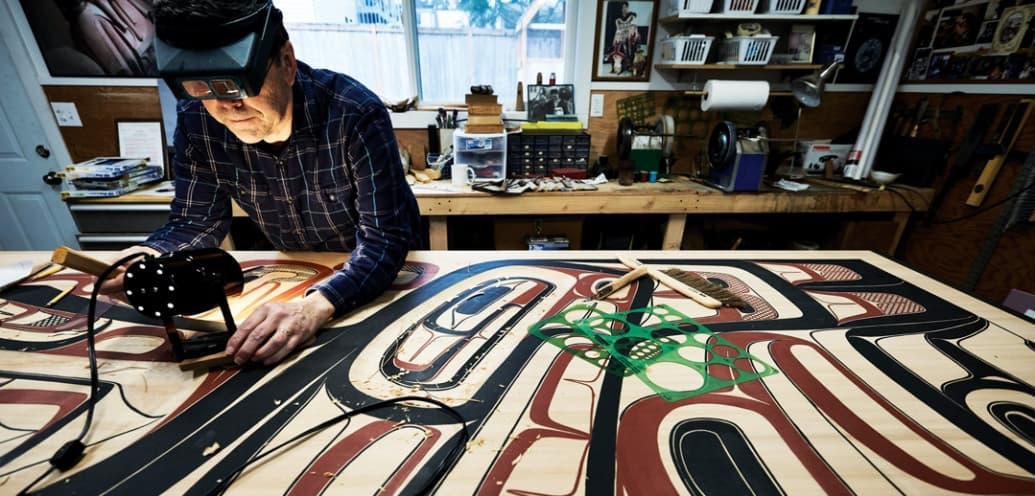On a rainy morning in Lynnwood, Washington, David Boxley ’74 heads to his backyard workshop to work on his current project.

It is a pair of large cedar doors, on which he is carving an intricately designed eagle and raven that will be painted in vibrant red and black.
Boxley, an internationally renowned Native American carver, is one of the most active totem pole carvers alive. He has created 78 totem poles, along with hundreds of ceremonial masks, bentwood boxes, paintings, and other items. His past commissions include totem poles for Walt Disney World in Florida and the Smithsonian National Museum of the American Indian in Washington, D.C. Boxley’s creations also reside in the collections of the emperor of Japan and the king of Sweden.
Boxley’s greatest honor, though, is the title bestowed on him by his people, the Tsimshian tribe of Alaska and British Columbia: “culture-bearer” — one who revives, preserves, and carries on their culture.
“David Boxley has been instrumental in revitalizing the cultural traditions of carving, song, and dance in his Tsimshian community,” says Kevin Gover, director of the National Museum of the American Indian. He says the museum is “honored” to have Boxley’s totem pole, “The Eagle and the Chief,” on permanent view.
Raised by his grandparents in Metlakatla, Alaska, Boxley grew up proud of his heritage, though Tsimshian culture had faded almost to extinction. In the 19th century, diseases from Europe decimated many Northwest indigenous communities, and most Tsimshian practices were lost when members of the tribe were forced to assimilate to European culture.
“Our culture was nearly gone, but my grandparents were still proud of who they were,” he says.

After earning a teaching degree at Seattle Pacific, Boxley taught high school for 13 years, beginning in Seattle. There, using pieces of cedar from a lumberyard, small blades from the local art store, and pictures of totem poles for reference, he began exploring traditional carving. He returned to Metlakatla for a time, but with no one there to train him, Boxley left teaching and moved his young family back to Seattle to study old pieces in museums and galleries.
“It’s best to learn from master carvers, but at that time, all I had was what they left behind,” he says. Spending hours each day in museums or carving in his garage, he gradually mastered his craft.

Carving a totem pole takes months. Boxley begins every pole with the same tool: an adze handmade by his grandfather, formed from the crook of an alder and part of a Volkswagen leaf spring. His medium? Old growth red cedars, towering giants with a glowing hue and resilient, fine-grained wood prime for weathering generations. “Totem poles tell stories,” he says. “They represent you, your family, or your people. You want them to last.”
Boxley’s attention to Tsimshian culture reaches beyond carving. He used a 1913 silent film and wax audio reel as source material to write songs in the traditional Tsimshian style, resurrect old dances, and construct dance regalia. In 1982, he hosted a traditional, long-forgotten ceremony called a potlatch in Metlakatla. Since then, he’s led potlatches across the Pacific Northwest.
Boxley’s solo carving days are now mostly behind him as his sons, stepson, and nephew learn the trade. His son David Robert teaches the Tsimshian language in Metlakatla and leads a traditional dance group that tours internationally.
Walk past Boxley’s workshop on a Friday afternoon, and you might also hear pounding drums, played by his 1-year-old grandson, leading a new generation of Tsimshian culture-bearers.
Watch this video of David Boxley creating a totem pole for the National Museum of the American Indian in Washington, D.C.




